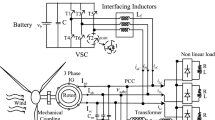Abstract
In this study, probabilistic power flow (PPF) for radial distribution systems (RDSs) integrated with photovoltaic (PV) distributed generators (DGs) is presented. The PPF is carried out using a combined approach of cumulants generating function and Gram–Charlier expansion. To express the intermittent nature of the PV power generation and demand powers, the random probabilities for solar irradiance and load demand are considered and modeled in the PPF. The benefits of PVDGs integration into RDS can be accomplished by their optimal placement and sizing. Hence, two optimization approaches are implemented to allocate the PVDG in the RDS. The first optimization approach utilizes a single-objective function based on particle swarm optimization (PSO) to minimize the total power losses in RDSs, while the second approach uses the multi-objective PSO (MOPSO) to minimize the total power losses and voltage deviation. However, in case of MOPSO, a fuzzy logic decision making is developed to adopt a suitable solution from the optimal Pareto set according to the decision-maker preference. The developed algorithm is verified using two standard IEEE radial distribution systems: IEEE 33-bus and 69-bus. The obtained results prove the ability of the developed algorithm in solving the PPF considering the optimal PVDG allocation with low computational time.




















Similar content being viewed by others
Abbreviations
- N :
-
Number of independent random
- X 1 :
-
Random variables
- \(f_{x1} ( {X_{1} }) \) :
-
Probability density function of random variables
- a1, a2, …, an :
-
Coefficients
- α γ :
-
γ-Order moment
- μ :
-
Expected mean value
- M γ :
-
Central moment
- Φ(x), φ(x):
-
CDF and PDF of a normal distribution
- σ :
-
Standard deviation
- \( c_{\upsilon } \) :
-
Constant coefficients, υ = 1, 2, 3, …
- \( H_{\upsilon } \left( x \right) \) :
-
Hermite polynomial
- K T :
-
Daily clearness index
- K d :
-
Hourly diffuse fraction
- G t,B :
-
Time averaged hourly total irradiance on a surface sloped at angle B to the horizontal
- \( p_{k} \left( {K_{\text{T}} ,\bar{K}_{\text{T}} } \right) \) :
-
PDF of random variable daily clearness index KT for a set of daily events having mean clearness index \( \bar{K}_{\text{T}} \)
- \( p_{k} \left( {K_{\text{d}} ,K_{t} } \right) \) :
-
PDF of random variable hourly diffuse fraction kd for a set of hourly events having mean diffuse fraction Kt
- C 1,λ :
-
Parameters are functions of KTu and \( \bar{K}_{\text{T}} \)
- K Tu :
-
Upper limit of the daily clearness index
- K dl :
-
Lower limit of the hourly diffuse fraction
- P pv :
-
PV electrical power
- η c :
-
PV cell’s electrical efficiency
- A :
-
PV generator surface area
- F i :
-
Fitness function
- P loss :
-
Total power losses
- z :
-
Branch number
- I z :
-
Branch current
- R z :
-
Resistance of branch
- n_br :
-
Number of branches
- V sep :
-
Specified voltage
- V i :
-
Voltage magnitude at bus ith
- VDi :
-
Voltage deviation at bus ith
- NG:
-
Numbers of generation units
- P d :
-
Active load demand
- \( P_{{{\text{g}}_{i} }} \) :
-
PVDG power generation
- \( P_{{{\text{g}}_{i} }}^{{\text{min}} } , P_{{{\text{g}}_{i} }}^{{\text{max} }} \) :
-
Min and max power limits of the PVDG
- V max :
-
Maximum voltage
- V min :
-
Minimum voltage
- Q loss :
-
Reactive power loss
- VDmax :
-
Maximum voltage deviation
- POP :
-
Population size
- k :
-
Counter refers to particles number
- p[k]:
-
Position of particle k
- v[k]:
-
Velocity of particle k
- x k :
-
Non-dominated vectors
- REP[k]:
-
Repository
- w :
-
Inertia weight
- r1, r2 :
-
Random numbers between 0 and 1
- Pbest[k]:
-
Best position for particle k
- \( F_{i}^{{\text{max} }} \) :
-
Maximum limit of the objective function i
- \( F_{i}^{{\text{min}} } \) :
-
Minimum limit of the objective function i
- \( U_{i}^{n} \) :
-
Normlized vlaue of objective function i at n non-dominated
- U loss :
-
Power loss normalized value
- U VD :
-
Voltage deviation normalized value
- U w :
-
Weighting of the Pareto solution normalized value
- PPF:
-
Probabilistic power flow
- RDSs:
-
Radial distribution systems
- PV:
-
Photovoltaic
- DGs:
-
Distributed generators
- PVDGs:
-
Photovoltaic distributed generators
- GCE:
-
Gram–Charlier expansion
- PSO:
-
Particle swarm optimization
- MOPSO:
-
Multi-objective PSO
- VD:
-
Voltage deviation
- CO2 :
-
Carbon dioxide
- DLF:
-
Deterministic load flow
- MCS:
-
Monte Carlo simulation
- MOOP:
-
Multi-objective optimization problems
- PAES:
-
Pareto archived evolution strategy
- NSGA-II:
-
Non-dominated sorting genetic algorithm
- SPEA:
-
Strength Pareto evolutionary algorithm
- PDFs:
-
Probabilistic density functions
- CDF:
-
Cumulative distribution function
- SD:
-
Standard deviation
- IA:
-
Improved analytical
- DAPSO:
-
Dynamic adaptation of PSO
- BSOA:
-
Backtracking search optimization algorithm
- LR:
-
Loss reduction
References
Jurado F, Cano A (2006) Optimal placement of biomass fuelled gas turbines for reduced losses. Energy Convers Manag 47(15–16):2673–2681
Hernández J, Medina A, Jurado F (2007) Optimal allocation and sizing for profitability and voltage enhancement of PV systems on feeders. Renew Energy 32(10):1768–1789
Balamurugan K, Srinivasan D (2011) Review of power flow studies on distribution network with distributed generation. Paper presented at the IEEE conference on power electronics and drive systems (PEDS)
Arrillaga J, Arnold C, Harker BJ (1983) Computer modelling of electrical power systems. Wiley
Deng X, Zhang P, Jin K, He J, Wang X, Wang Y (2019) Probabilistic load flow method considering large-scale wind power integration. J Mod Power Syst Clean Energy 7(4):813–825
Gruosso G, Maffezzoni P, Zhang Z, Daniel L (2019) Probabilistic load flow methodology for distribution networks including loads uncertainty. Int J Electr Power Energy Syst 106:392–400
Zhang J, Xiong G, Meng K, Yu P, Yao G, Dong Z (2019) An improved probabilistic load flow simulation method considering correlated stochastic variables. Int J Electr Power Energy Syst 111:260–268
Bijwe P, Raju GV (2006) Fuzzy distribution power flow for weakly meshed systems. IEEE Trans Power Syst 21(4):1645–1652
Jiang X, Chen YC, Domínguez-García AD (2013) A set-theoretic framework to assess the impact of variable generation on the power flow. IEEE Trans Power Syst 28(2):855–867
Su C-L (2005) Probabilistic load-flow computation using point estimate method. IEEE Trans Power Syst 20(4):1843–1851
Ruiz-Rodriguez F, Hernandez J, Jurado F (2012) Probabilistic load flow for radial distribution networks with photovoltaic generators. IET Renew Power Gener 6(2):110–121
Vidović PM, Sarić AT (2017) A novel correlated intervals-based algorithm for distribution power flow calculation. Int J Electr Power Energy Syst 90:245–255
Lopes JP, Mendonça Â, Fonseca N, Seca L (2005) Voltage and reactive power control provided by DG units. Paper presented at the CIGRE symposium: power systems with dispersed generation, Athens, Greece
Acharya N, Mahat P, Mithulananthan N (2006) An analytical approach for DG allocation in primary distribution network. Int J Electr Power Energy Syst 28(10):669–678
Atwa Y, El-Saadany E, Salama M, Seethapathy R (2010) Optimal renewable resources mix for distribution system energy loss minimization. IEEE Trans Power Syst 25(1):360–370
Borges CL, Falcao DM (2006) Optimal distributed generation allocation for reliability, losses, and voltage improvement. Int J Electr Power Energy Syst 28(6):413–420
Knowles JD, Corne DW (2000) Approximating the nondominated front using the Pareto archived evolution strategy. Evol Comput 8(2):149–172
Deb K, Pratap A, Agarwal S, Meyarivan T (2002) A fast and elitist multiobjective genetic algorithm: NSGA-II. IEEE Trans Evol Comput 6(2):182–197
Zitzler E, Laumanns M, Thiele L (2001) SPEA2: improving the strength pareto evolutionary algorithm. TIK-report, 103
Coello CAC, Pulido GT, Lechuga MS (2004) Handling multiple objectives with particle swarm optimization. IEEE Trans Evol Comput 8(3):256–279
Zhang P, Lee ST (2004) Probabilistic load flow computation using the method of combined cumulants and Gram–Charlier expansion. IEEE Trans Power Syst 19(1):676–682
Allan R, Al-Shakarchi M (1976) Probabilistic ac load flow. Paper presented at the proceedings of the institution of electrical engineers
Rajaram R, Kumar KS, Rajasekar N (2015) Power system reconfiguration in a radial distribution network for reducing losses and to improve voltage profile using modified plant growth simulation algorithm with distributed generation (DG). Energy Rep 1:116–122
Baran M, Wu FF (1989) Optimal sizing of capacitors placed on a radial distribution system. IEEE Trans Power Deliv 4(1):735–743
Venkatesh B, Ranjan R (2003) Optimal radial distribution system reconfiguration using fuzzy adaptation of evolutionary programming. Int J Electr Power Energy Syst 25(10):775–780
Hollands K, Crha S (1987) A probability density function for the diffuse fraction, with applications. Sol Energy 38(4):237–245
Hollands KGT, Huget R (1983) A probability density function for the clearness index, with applications. Sol Energy 30(3):195–209
Hung DQ, Mithulananthan N (2013) Multiple distributed generator placement in primary distribution networks for loss reduction. IEEE Trans Ind Electron 60(4):1700–1708
Manafi H, Ghadimi N, Ojaroudi M, Farhadi P (2013) Optimal placement of distributed generations in radial distribution systems using various PSO and DE algorithms. Elektronika ir Elektrotechnika 19(10):53–57
El-Fergany A (2015) Optimal allocation of multi-type distributed generators using backtracking search optimization algorithm. Int J Electr Power Energy Syst 64:1197–1205
Author information
Authors and Affiliations
Corresponding author
Additional information
Publisher's Note
Springer Nature remains neutral with regard to jurisdictional claims in published maps and institutional affiliations.
Rights and permissions
About this article
Cite this article
Kamel, S., Selim, A., Ahmed, W. et al. Single- and multi-objective optimization for photovoltaic distributed generators implementation in probabilistic power flow algorithm. Electr Eng 102, 331–347 (2020). https://doi.org/10.1007/s00202-019-00878-7
Received:
Accepted:
Published:
Issue Date:
DOI: https://doi.org/10.1007/s00202-019-00878-7




